Understanding the Need for Spacious Cages for Parakeets
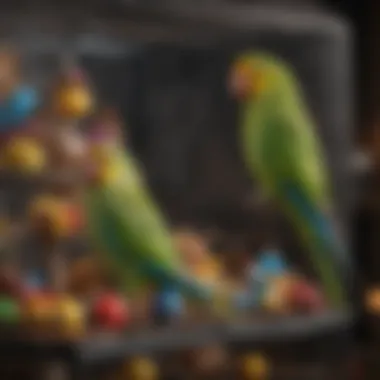
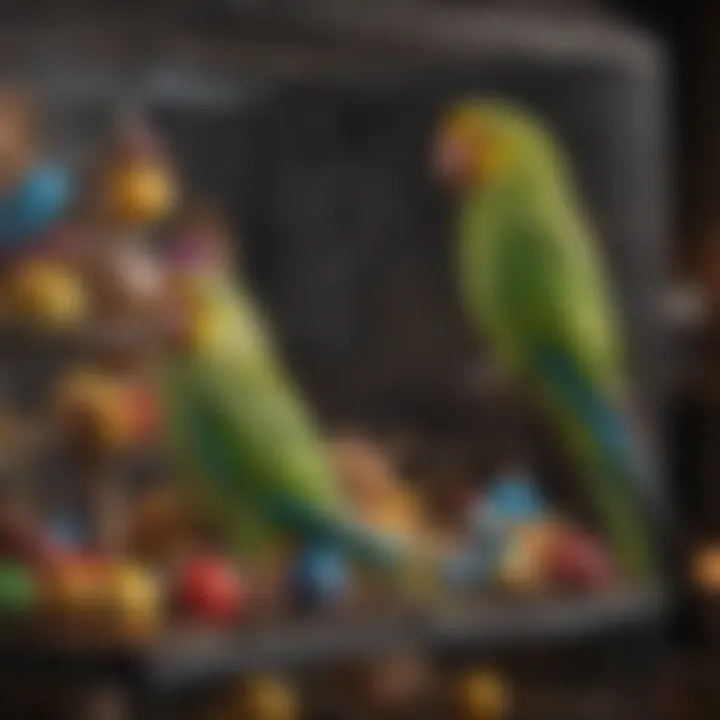
Intro
When it comes to parakeets, the size of their cage can make all the difference in the world. Think of it like a home; if it’s cramped and cluttered, it can lead to a host of issues for the little feathered friends. Parakeets are lively creatures, and providing them with ample space to roam, play, and express themselves is fundamental to their health and happiness. In this article, we will dive into why spacious cages are so vital, covering aspects like cage setup, daily care, and the enrichment needed for these social birds.
Care Tips
Taking care of a parakeet is not just about feeding and cleaning; it's about creating an environment where they can thrive.
Daily Care Routines
Daily routines should include checking the bird's food and water, ensuring the cage is clean, and providing fresh perches or toys. Birds thrive on routine, which can help them feel more secure.
Cage Setup and Maintenance
When setting up a cage for your parakeet, big is always better. A cage that measures at least 24 inches wide, 18 inches deep, and 24 inches high is a good starting point. Place perches of varying sizes to keep their feet healthy. Additionally, try to avoid plastic perches, as they can lead to foot issues. Instead, natural wood is a great option.
Hygiene and Cleaning Practices
Cleanliness is paramount. Regularly clean the perches, toys, and the cage floor. Using vinegar and water is a good natural alternative to chemical cleaners, which may harm birds.
Seasonal Care Adjustments
In colder months, ensure the cage is in a location free from drafts. Offer extra bedding or covers during chilly nights. Similarly, during summer, maintain hydration and consider providing shaded areas within the cage.
Behavioral Insights
Understanding your parakeet's behavior can lead to a stronger bond and a more harmonious household.
Understanding Bird Body Language
Parakeets communicate a lot through their body language. A puffed-up bird may be feeling threatened, while a relaxed stance indicates comfort.
Common Behavioral Issues and Solutions
Sometimes, parakeets may engage in biting or excessive yelling. Identifying triggers for this behavior—like lack of interaction or boredom—may help in addressing the root cause. Providing them ample toys and social interaction goes a long way.
Positive Reinforcement Techniques
Rewarding your parakeet with treats or affection when it exhibits good behavior can reinforce positive habits. This is often more effective than punishing unwanted behavior.
Social Interaction Needs
Parakeets are social creatures. If you’re away for long periods, consider getting a second bird as a companion. Alternatively, daily interaction and playtime can substitute for the lack of a buddy.
Nutrition Guides
A proper diet is crucial for a parakeet’s well-being.
Essential Diet Components
Fresh fruits and vegetables should be a daily staple. A good quality seed mix or pellets should serve as a fundamental part of their diet but shouldn't be the sole component.
Safe and Toxic Foods
Be sure to research safe food options such as leafy greens or apples, while keeping toxic items like avocados and chocolate far from reach.
Supplements and Treats
Treats can be beneficial, but moderation is key. Look for products that promote healthy beak and feather condition.
Feeding Strategies for Different Species
Different species may require different nutritional values. Researching and customizing their diet can lead to better health.
Wellness and Health
Just like any pet, parakeets require routine care pertaining to health.
Routine Health Checkups
Regular visits to an avian vet can ensure your parakeet stays free of common health issues.
Identifying Symptoms of Illness
Look for signs such as puffing up, lethargy, or unusual droppings, and consult an expert when in doubt.
Preventative Care and Vaccinations
Some vaccinations might be applicable depending on your region; discussing this with your vet is essential for preventative health.
Mental and Emotional Well-being
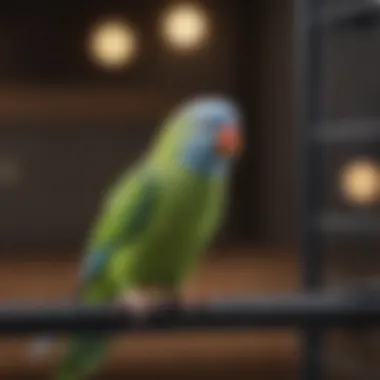
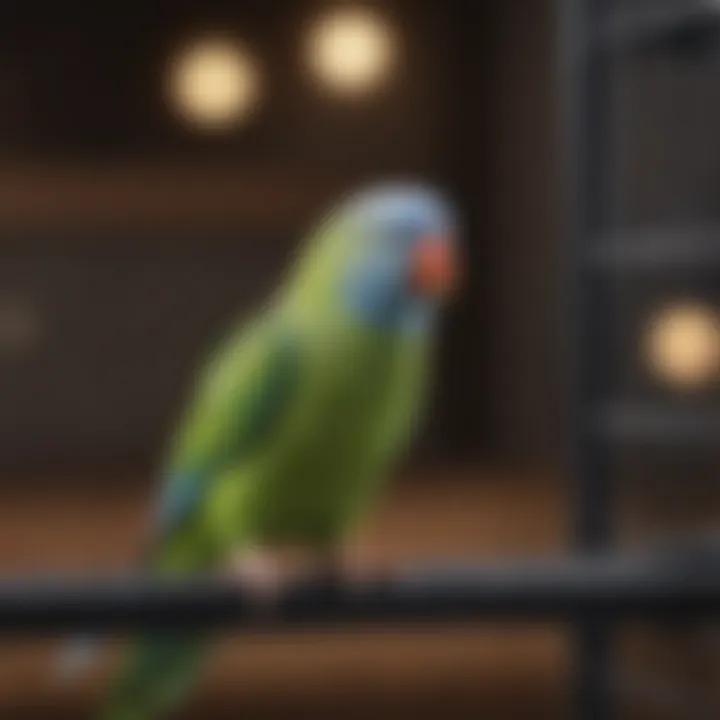
Stimulating the mind is equally as important as physical health. Activities that encourage exploration or flight can help maintain this well-being.
Enriching Activities
To keep parakeets engaged, exploring various activities can add a splash of joy.
Toys and Playtime Ideas
Rotate toys frequently to keep them intrigued. For instance, hanging mirrors and shreddable toys can provide countless entertainment hours.
Training and Tricks
Parakeets are trainable. Simple commands and tricks can be taught, offering both mental stimulation and a way to bond.
Outdoor Activities and Interaction
Supervised outdoor time allows birds to experience fresh air and new sights. Always ensure the area is safe and free from potential dangers.
DIY Projects for Mental Stimulation
Creating your toys or hiding treats within the cage can encourage natural exploration and cognitive skills.
It's essential for bird owners to understand the significance of a spacious cage. A well-sized cage is not just a home; it can be a sanctuary for their mental and physical well-being.
Understanding Parakeet Needs
Understanding the needs of parakeets is the cornerstone for nurturing their health and happiness. These small, vibrant birds aren’t just pets; they are social creatures that thrive in enriched environments. Their overall well-being is intricately linked to the space they inhabit, the activities they engage in, and the mental stimulation they receive. By diving deeper into their specific needs, owners can make informed choices about cage selection and setup that ultimately contribute to a fulfilling life for these feathered friends.
Social Behavior of Parakeets
Parakeets are naturally social animals. They often live in flocks in the wild, which means they flourish on companionship, whether it’s with other birds or human interaction. A spacious cage allows for more than just room to fly; it also facilitates interaction. It’s essential to provide opportunities for parakeets to socialize, whether through bonding with other birds or engaging with their owners. A larger cage may also help prevent territorial squabbles if you choose to house multiple birds together, as they can establish their own personal space while still enjoying social interaction.
Social behaviors include mutual preening, playing together, and imitating sounds. Providing adequate space in a cage promotes these interactions and helps to reduce stress. When these needs are met, parakeets show higher levels of happiness. An isolated bird, confined to a small cage, may exhibit signs of loneliness, such as excessive vocalizations or behavioral changes, which could lead to health problems down the line.
Physical Activity Requirements
Physical activity is as critical for parakeets as it is for humans. In a cage that’s too small, these birds can’t move around freely, which might lead to obesity and muscle atrophy. An optimal cage size shouldn’t just allow a parakeet to stand; it should give them the freedom to fly, climb, and explore.
Parakeets are known to be lively and inquisitive, often needing a good amount of exercise to keep them fit both physically and mentally. Having larger cages means they can flap their wings and make short flights, which play a significant role in their overall muscle development and cardiovascular health. Avoid feeling sorry for your birds by just letting them hop around in a small space; instead, consider that they need room. If crampped, they might just become couch potatoes, and that’s a recipe for a short-lived pet.
Mental Stimulation in Avian Life
Mental stimulation is another critical aspect of parakeet welfare. Just like humans, birds get bored too. In the wild, parakeets have to scavenge for food, navigate through trees, and avoid predators— all valuable exercises that keep their minds sharp. A big cage provides the perfect environment to introduce toys and foraging opportunities that mimic their natural behaviors.
"Birds need to feel they have options; an enriched environment keeps them from getting into trouble."
When setting up a cage, owners should include a mix of toys—like swings, bells, and puzzles—to encourage exploration. Moreover, rearranging the setup regularly can spark curiosity. A larger cage not only accommodates all these activities but also promotes the psychological well-being of the parakeet. Without mental engagement, even the prettiest bird can become a shadow of its vibrant self, leading to issues like feather plucking or excessive squawking.
In summary, understanding parakeet needs requires a comprehensive assessment of their social behaviors, physical activity, and mental stimulation. A thoughtful approach towards creating an adequate living environment will result in healthier, happier birds.
Evaluating Cage Size
Determining the right size of a cage for your parakeet isn’t just a matter of aesthetics or personal preference; it is crucial for the overall health and happiness of your feathered friend. A big cage supports their natural behavior, offers space for movement, and allows for an enriching environment. If you take the time to unpack the given dimensions, you not only improve their physical well-being but also help in preventing behavioral issues that stem from confinement. Choosing inadequate cage size could lead to stress and restlessness, which, bear in mind, often results in unwanted behaviors.
Minimum Cage Dimensions for Parakeets
When considering minimum cage dimensions, it's best not to just go with the bare minimum. The recommended dimensions for two parakeets should generally be at least 24” wide x 18” deep x 24” high. However, bigger is always better. Some experienced owners suggest even larger sizes to encourage more flight and exploration. Imagine living in a small room with barely space to turn around; that’s the reality for many birds in small cages. A more spacious habitat allows them to stretch their wings and engage in daily activities like hopping, climbing, and socializing effectively.
- Ideally:
- Single Parakeet: 24” wide x 18” deep x 24” high
- Two Parakeets: 36” wide x 24” deep x 24” high
Choosing a cage that exceeds these dimensions creates a much better quality of life, ultimately leading to healthier, happier birds. Remember, parakeets are naturally social and agile creatures.
Impact of Cage Size on Behavior
The size of a cage directly influences not only your parakeet’s physical health but also their psychological state. In a cramped environment, parakeets might exhibit signs of stress, which can manifest through plucking feathers or incessant squawking. Larger cages encourage more movement and make for a well-adjusted, active bird. Research has shown that expanding cage dimensions can lead to a noticeable decline in repetitive behaviors that indicate discontent or boredom.
Here’s a short list of behaviors affected by cage size:
- Increased activity levels
- Enhanced social interactions
- Reduced stress-related behaviors
A roomy cage also leads to a more engaging environment where parakeets can explore various perches and toys without feeling restricted. Their temperament stabilizes, better mirroring their natural behavior when they have enough space to roam freely.
Comparing Different Cage Types
Not all cages are created equal, and the type of cage can impact how much space a parakeet can utilize effectively. It's not just about the dimensions; the cage’s design plays a crucial role.
- Rectangular Cages: These provide an excellent amount of usable space and are generally more practical for bird owners. They offer more stretch for their wings than round or irregularly shaped cages.
- Flight Cages: If you’re serious about mimicking a parakeet's natural habitat, opt for a flight cage. These are specifically designed to provide maximum space for flying and climbing.
- Play Cages: While not meant for permanent housing, these types serve as wonderful adjuncts for social captivity, allowing for supervised playtime outside a traditional cage.
Each cage type comes with its unique pros and cons. Thus, choosing the right kind hinges not only on cage size but also on your lifestyle and how cambered you want your parakeet's experience to be. Don't skimp on cage quality; this is where your parakeet will spend a significant portion of its life. Look to invest in a product that suits both your requirements and your bird’s behavior, ensuring that the animal has enough room to soar.
Choosing Appropriate Materials
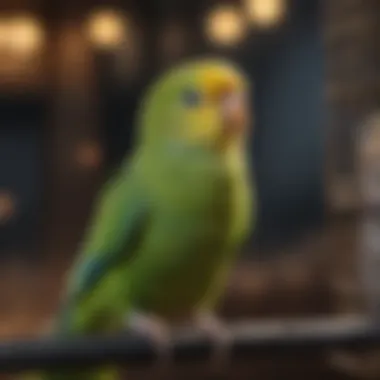
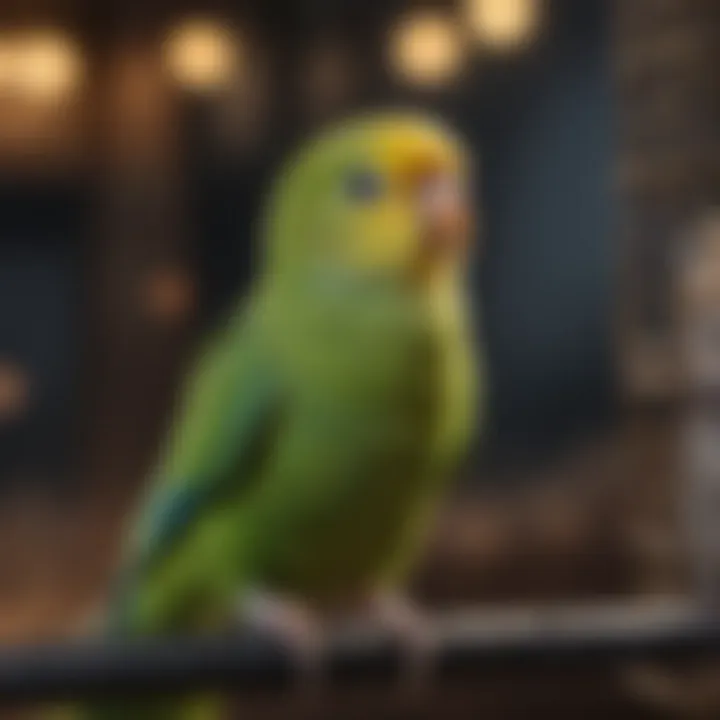
Selecting the right materials for your parakeet's cage is crucial to ensure their health and well-being. It's not just about selecting something that looks good; the materials you choose can significantly impact their safety, comfort, and overall happiness. In this section, we’ll explore some common cage materials, consider their durability, and evaluate the paints and coatings that can be used.
Popular Cage Materials
When it comes to parakeet cages, a few materials are particularly common. The most popular choices include:
- Stainless Steel: Durable and resistant to rust, stainless steel is a top choice for many bird owners. It’s easy to clean and can last for many years without losing its integrity.
- Wrought Iron: Another strong option, wrought iron cages often feature decorative designs. However, the potential for rust means they require proper care and maintenance.
- Plastic: Used for model cages, plastic is lightweight and easy to manipulate. However, it might not be as sturdy as metal options and can wear down over time.
- Acrylic: This material can be excellent for smaller living spaces. Acrylic is easier to clean compared to some metals, but it is important to note that it can scratch easily.
Each material has its pros and cons, so think carefully about what will work best for your situation.
Durability and Safety Considerations
One of the key factors in choosing a cage material is its durability. A cage that can withstand the test of time will provide a safer environment for your parakeet. Here are points to ponder:
- Corrosion Resistance: Stainless steel is likely the best option due to its resistance to rust. Regular cleaning can also help maintain its longevity.
- Chemical Safety: Avoid materials treated with harmful chemicals. Parakeets tend to chew on their environment, and exposure to toxic substances can lead to serious health issues.
- Structural Integrity: A sturdy cage should be able to withstand a parakeet's active nature. Check for weak points or flimsy components that could lead to escapes and potential injury.
"A well-chosen cage material is a vital first step in promoting a happy and healthy life for parakeets."
Evaluating Paints and Coatings
If your chosen cage has any painted surfaces or coatings, evaluation becomes essential. Here are some considerations:
- Non-Toxic Paints: Look for cages that utilize bird-safe paints. Many commercial options advertise themselves as safe, but always verify the claims through trusted sources.
- Coating Durability: Examine how well the paint holds up over time. A cage subject to scratching and chewing should ideally have a durable finish that can endure daily wear.
- Absence of Lead and Zinc: Verify that the paint doesn’t contain harmful metals, as these can be fatal to birds. If possible, select powder-coated options that are specifically labeled as bird-safe.
Enhancing Cage Enrichment
To truly foster a healthy environment for parakeets, enriching their cages is not just an eye-catching option but a necessity. Without proper enrichment, even the largest cages can feel confining and dull. Parakeets are intelligent creatures. They thrive on mental stimulation and variety in their environment. Enhancing cage enrichment contributes significantly to their overall happiness and well-being. Let's dive into essential aspects of enriching a parakeet's cage.
Essential Perches and Toys
Considered the foundation of cage enrichment, perches and toys play a fundamental role in keeping your feathered friend active and engaged. When choosing perches, diversity is key. Mix various materials such as wood, rope, and even natural branches. These not only offer a comfortable resting place but also encourage climbing and activity. Try to provide perches of differing diameters. This helps exercise their feet and prevents foot ailments that can arise from prolonged use of flat surfaces.
Toys should likewise be selected with care. Parakeets are naturally curious and enjoy toys that allow for exploration. Here are some types to consider:
- Foraging toys that hold treats
- Chewing items made of safe wood or paper
- Puzzle toys that challenge them mentally
Having a rotation system for toys can keep their interest alive—switch them out every few weeks. Remember, a bored parakeet can turn into a destructive parakeet.
Creating Interactive Spaces
Creating interactive spaces within the cage contributes to a lively environment. Think of it like setting up a little playground. Not only does this enhance their physical activity, but it also taps into their natural instincts to explore and engage. You can achieve this by incorporating elements like:
- Ladders for climbing
- Swings that allow for movement
- Mirrors that catch their fancy
When designing these spaces, ensure there’s enough room for your parakeet to explore without feeling cramped. Environmental enrichment encourages them to engage in activities that mirror their natural behavior in the wild. This approach not only keeps them occupied but develops their confidence as well.
Promoting Natural Behaviors
A cage that nurtures natural behaviors can significantly impact your parakeet’s mood. In the wild, parakeets are social, inquisitive, and active. Reproducing these aspects in captivity involves recognizing what they love to do. Here’s how to encourage these behaviors:
- Encourage social play by placing multiple perches close together, fostering interaction among birds if more than one is kept.
- Create foraging opportunities by hiding treats around the cage or utilizing food puzzles.
- Naturalistic settings, where you simulate branches, shrubs, or even edible plants, can mimic their natural environment.
The bottom line is that enrichment is vital. It helps to break up the monotony of their daily life inside a cage. As the saying goes, a happy bird makes a happy owner. Every piece you add not only enhances their habitat but also contributes to their emotional well-being.
"An enriched cage is akin to a vibrant city, teeming with opportunities for adventure and exploration!"
In summary, enhancing cage enrichment through thoughtful perches, interactive spaces, and natural behaviors can lead to a happier parakeet and a more enjoyable experience for you as a bird owner. The bond formed in shared engagement is one neither of you will regret.
Common Misconceptions
Understanding common misconceptions about cage size is essential for anyone looking to provide the best living environment for their pet parakeets. These misconceptions can lead to decisions that negatively impact the birds' health and happiness. By addressing and dismantling these myths, we can create a clearer picture of what parakeets truly need.
Many people think a small cage is sufficient, believing that as long as the bird has food and water, it will be happy. However, this view is far from the truth. Parakeets are social creatures, full of energy and curiosity. They require space to move, engage, and exhibit natural behaviors. A misunderstanding of why space matters leads to poor living conditions, often resulting in stress and behavioral issues.
The Myth of Small Cages
The idea that a smaller cage can fulfill a parakeet’s needs is one of the more insidious myths. This notion is often borne out of convenience or misguided priorities. Many pet owners might picture a confined cage as a cozy nook for their birds. But consider this—the size of the environment directly affects these little creatures' overall well-being.
Smaller cages restrict the parakeet’s movement, which can lead to restless behavior and negative psychological effects. A cramped habitat limits their ability to exercise and socialize, contributing to a decrease in their vitality.
Research suggests that birds in larger, more spacious environments tend to display fewer signs of stress and aggression. They thrive when they can spread their wings literally and figuratively. This just underscores the importance of investing time and resources into understanding appropriate cage sizes for your parakeet’s unique needs.
Misunderstandings Regarding Cage Space
Even when people acknowledge that cage size matters, misunderstandings about what constitutes appropriate space remain prevalent. Some believe that enough space is just about following recommended dimensions, which can often lead to overly simplistic interpretations.
For instance, a cage advertised as suitable for parakeets may meet minimum size requirements yet still feel claustrophobic. Parakeets benefit from vertical space as much as horizontal. A tall cage with lots of perches allows them to explore and fly upward, mimicking their natural habitat.
Moreover, the layout of the cage is critically important. It’s not just the dimensions that matter, but how the space is utilized. Ensuring the cage is arranged in a manner that promotes interaction with different enrichments—like toys or natural branches—can significantly influence your bird's happiness.
Size versus Quality of Space
When discussing cages, it’s crucial to differentiate between size and quality of the living environment. A large cage stuffed to the brim with toys might sound appealing, but if it lacks proper organization and structure, it could still fall short of meeting the parakeet's needs.
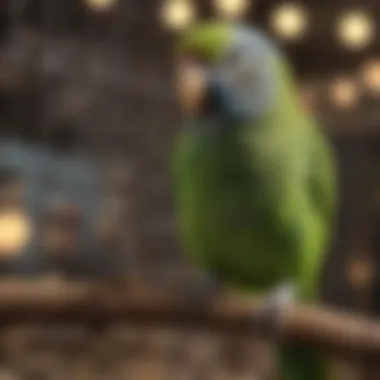
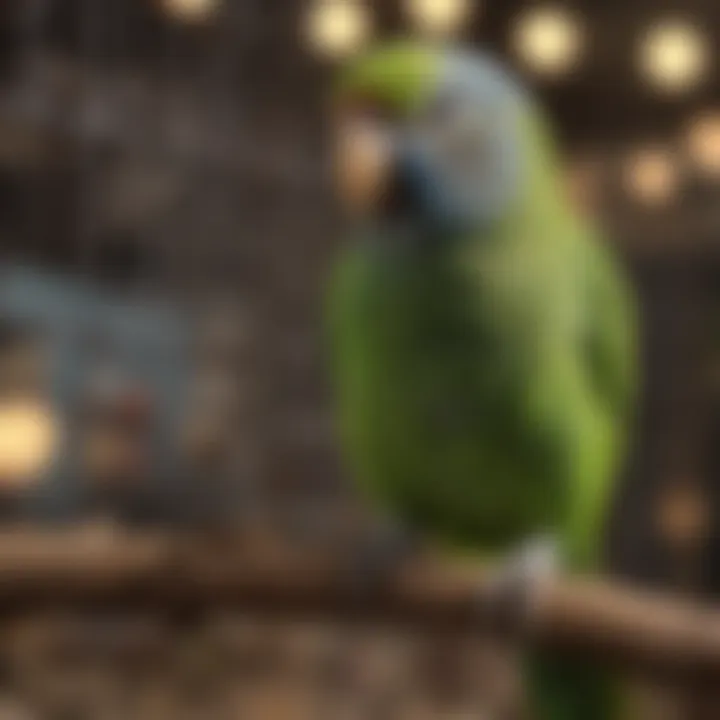
Quality of space factors in several elements:
- Accessibility: Parakeets should be able to easily reach their food and water without straining.
- Comfort: Proper perches, preferably made from natural materials, should be installed for their comfort and foot health.
- Safety: Adequate space should ensure that the bird can avoid hazards, like falling objects or close proximity to heat sources.
Setting Up the Perfect Cage
Creating a nurturing environment for parakeets begins with setting up the perfect cage. This part of the process is not just about putting the cage in a corner and filling it with toys. It's a thoughtful approach to ensure the happiness and well-being of these lively little creatures. Proper cage setup can help boost both their physical activity and mental stimulation, making it vital for fulfilling their natural behaviors and needs.
Cage Placement in the Home
The placement of the cage is crucial. Parakeets are social animals that thrive on interaction; therefore, positioning their cage in a lively part of the home can enhance their quality of life. Avoid putting the cage in dark or isolated areas like basements or back rooms. Instead, choose a spot where they can see and hear family activities.
Good locations include:
- Living rooms or dining areas, where family gatherings happen.
- Rooms with ample natural light, allowing them to monitor their surroundings.
- Away from direct drafts or excessive heat sources, which can stress them.
This way, they can engage with their environment while still feeling secure. Additionally, hanging out at certain eye-level can also make them feel comfortable and part of the household dynamic instead of just decorative pieces.
Optimizing Space for Movement
Just like us, parakeets need room to stretch their wings and frolic around. An adequately sized cage provides the necessary space for them to fly short distances. To optimize space, include:
- Horizontal space: Wide cages encourage flapping and play. Ideal dimensions might reach 30 inches in width.
- Vertical height: Parakeets love climbing. A taller cage lets them ascend to their favorite perches. Aim for about 24 inches of height.
- Layout planning: Organize perches at various heights and distances to promote natural flying. This encourages exercise and prevents boredom.
It's essential to keep in mind that the more room they have for movement, the more active and engaged they'll be.
Establishing a Routine
Setting a daily routine can help your parakeet adjust to their environment and become more comfortable over time. Routine may include:
- Feeding times: Establish consistent meal schedules.
- Out-of-cage time: Allocate daily periods when they can fly freely in supervised spaces. Ideally, this should be at least two hours each day.
- Social interaction: Dedicate time for play and training, building trust and encouraging bonding.
Birds are creatures of habit, and a consistent structure will reduce stress. Through interaction and enrichment, owners can help their parakeets lead enriched lives while ensuring this setup becomes a lasting, healthy environment.
Remember, a well-setup cage doesn’t just house your bird; it nurtures their spirit and encourages their unique personalities to shine!
Monitoring Parakeet Behavior
Keeping an eye on your parakeet's behavior is essential for understanding their overall well-being. A spacious cage plays a crucial role in this aspect; when parakeets have room to roam, fly, and play, their behavioral nuances become clearer. Noticing changes in their actions can indicate their happiness levels or hidden stressors. This makes monitoring behavior very significant, as it can alert you to adjustments needed for their living conditions.
Signs of Stress in Confinement
Identifying signs of stress in your parakeet is vital, especially in relation to the size of their cage. Parakeets are social creatures, and when they feel confined, it can lead to behavioral issues. Symptoms of stress include:
- Excessive vocalization: When parakeets start squawking more than usual, it can signal unease or boredom.
- Feather plucking: This can be a reaction to anxiety caused by limited space.
- Aggression: A parakeet that feels crowded may become nippy or aggressive towards other birds or even towards its owner.
- Lethargy: If your bird is uncommonly quiet and seems to prefer sitting in one spot, it may not be feeling secure in its environment.
The longer these behaviors persist, the more detrimental they may become. Big cages can alleviate many of these stressors, allowing your feathered friend to spread its wings—literally and figuratively.
Behavioral Changes with Space
The correlation between cage size and behavior cannot be overstated. Bigger cages offer parakeets not just room, but freedom to exhibit natural behaviors. You’ll likely notice:
- Increased playfulness: With ample toys and perches, your parakeets will engage in more active playtime, which is crucial for their mental and physical health.
- Social interactions: A larger space can encourage more social behavior, whether it's chatting with other birds or interacting with you more often.
- Exploration trends: A roomy cage tempts parakeets to explore their habitat, keeping them engaged and less bored.
Understanding these changes is key to fostering a stimulating environment that respects their instincts.
Reinforcing Positive Habits
To nurture positive behaviors in your parakeet, it’s invaluable to consistently monitor and adjust their environment. Reinforcement can take many forms:
- Treats for good behavior: Rewards can help cement positive interactions; if your parakeet engages in playful activities or socializes well, treat them with a small snack.
- Encouragement through interaction: When your bird displays happy, safe behaviors, be sure to spend time interacting. These actions reward their positivity and cultivate a strong bond.
- Routine checks: Regularly checking for any signs of stress allows you to promptly address any issues. Adjustment of cage setup or adding new toys can prevent negative behaviors from forming.
By reinforcing these habits, you're not just improving their behavior; you’re enhancing their overall quality of life. Monitoring provides the insight needed to tailor the cage experience perfectly.
Remember, a spacious home for your parakeet keeps them healthy, happy, and helps you catch and respond to changes early!
Link for further exploration of parakeet behaviors can be found at Wikipedia.
By observing and interpreting these behaviors, you can ensure your parakeet thrives in its environment. Ensuring they're in a spacious cage is not merely about physical space, but also about providing a framework for a fulfilling life.
Epilogue
The closing thoughts on the importance of spacious cages for parakeets encapsulate the essence of why adequate space is paramount for these vibrant creatures. In this article, we have examined various elements surrounding cage size, demonstrating their profound impact on parakeet behavior and well-being. A spacious cage not only provides ample room for flight and exploration but also significantly reduces stress levels. Parakeets, being inherently social birds, thrive in environments that allow them to exhibit natural tendencies, which spacious cages facilitate.
> In effect, larger cages enhance a parakeet’s quality of life by offering the freedom to move, interact, and showcase their unique personalities.
Many parakeet owners might assume that as long as a bird is fed and has basic shelter, it will be content. However, the truth lies in understanding the complexity of parakeet needs—their physical, mental, and emotional health hinges on having enough space to flourish. This understanding emphasizes a key takeaway: the notion that bigger cages simply equal happier birds is not just a whimsical saying; it’s a valuable principle supported by various studies and expert recommendations.
Reiterating the Importance of Space
When we revisit the significance of cage space, it’s crucial to recognize the direct correlation between a parakeet’s living area and its overall behavior. Parakeets are naturally inclined to fly and frolic; denying them the space to engage in these activities can lead to various negative behaviors. Stress-induced behaviors, such as feather plucking or incessant chirping, often arise from confinement in too small a cage.
The ideal cage should not only meet but exceed the minimum requirements. A larger enclosure invites exploration and interaction, allowing parakeets to engage in social behaviors that are incredibly important for their mental stimulation. Furthermore, having a spacious environment encourages positive interactions between the birds themselves, especially if your home is also shared with other parakeets.
Encouraging Responsible Ownership
The notion of responsible pet ownership takes on a broader significance when discussing parakeets. Each decision—from the type of cage to how it is placed in the home—affects the well-being of these feathered companions. Committing to providing a large cage means taking on the responsibility of ensuring that the bird’s environment supports its happiness and health.
As aspiring bird parents or experienced owners, understanding the requirements of your feathered friends is paramount. A larger cage is not merely an expense; it is an investment in the quality of life of your parakeets. Consider how cage dimensions play a role in their ability to thrive—not just survive.















